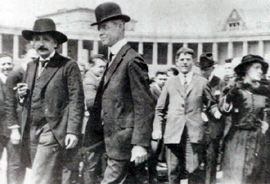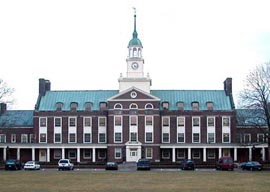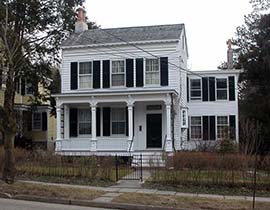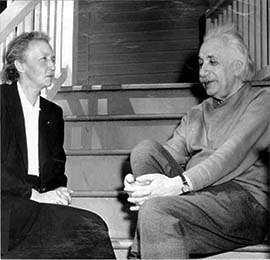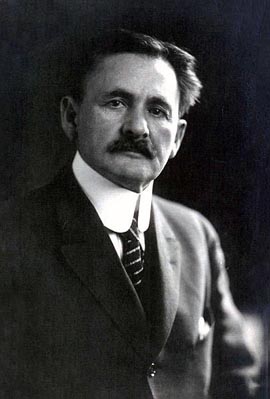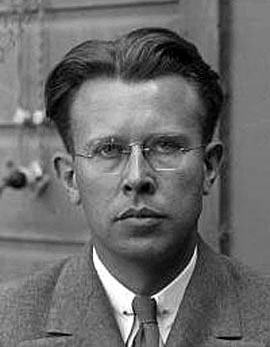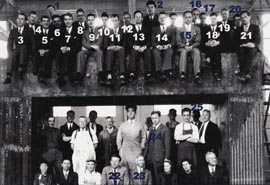Einstein in the United States
This page is under construction. Please come again.
Einstein made his first visit to the United States in 1921, and gave a series of lectures at Princeton University. In 1933, he came to Princeton again and stayed there until his last day in 1955. Was the United States ready for Einstein?
- When Einstein arrived at New York's Seaport (near Wall Street) in 1921,
Dean Henry Burchard Fine of Princeton University went there to greet him.
He gave a series of five lectures at the University on his new theory of
relativity. Scientists all over the United States packed the lecture hall
for his talks.
In the 1920s, Louis Bamberger and Caroline Bamberger Fuld had operated a department store in Newark and invested their earnings in the stock market, but they pulled out their investment in 1929 right before the market crash. They then decided to do something good to the state of New Jersey. In 1930, they set up a medical research institute in Princeton. I assume Caroline was Bamberger's daughter, and her husband's last name was Fuld. The Institute's main building is called Fuld Hall.
- The first director of the Institute was Abraham Flexner who initiated
the idea of inviting Albert Einstein from Germany. Einstein thus came to
Princeton in 1933. He settled down at a house on Mercer Street. Einstein
became a citizen of the United States in 1940.
I was fortunate enough to meet a man who was at the U.S. Courthouse in Trenton where Einstein's citizenship ceremoney took place. His name is Bill Holcomb, and I met him at a highway restaurant near Princeton in 2004. Here is my photo with him. His wife attended Princeton's Westminster Choir College and used to sing for Einstein. Click here for a detailed story.
- While in Princeton, Einstein did not talk to too many people. He talked
often with Kurt Goedel who joined the Institute in 1940. Goedel is famous
for his "Incomplete Theorems." I do not know what came out from the
association of the two great thinkers.
Click here for some of the physicists he met while in Princeton. In 1954, Werner Heisenberg visited his house, but was not able to produce significant scientific results. Click here for a story.
Irene Joliot-Curie also visited his house, and here is her photo with Einstein at the front steps of his house. Johanna Fantova was a frequent visitor to Einstein's house during his last years.
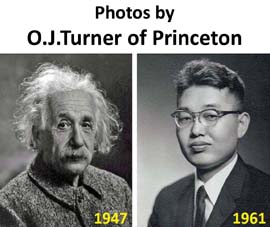
Justified? - Orren Jack Turner was Princeton's distinguished photographer.
- He took this photo of Einstein in 1947.
- He took a photo of myself the day before my Princeton graduation in 1961.
Einstein died in 1955, and I went to Princeton as a graduate student in 1958. I thus was not able to have a photo with him, but I am at liberty of combining his photo with mine taken by the same person on one webpage, but the question is whether I have done enough scientistic work to deserve to be with Einstein. Click here for my answer.
- He took this photo of Einstein in 1947.
- Albert Abraham Michelson was born in Poland in 1852 and came to the
United States with his parents when he was two years old. He studied at the
U.S. Naval Academy in Annapolis. There are many interesting
stories about how he was able to enter this elite school with Jewish background.
I was deeply moved when I heard a colloquium talk about
his life.
Michelson developed precision devices to measure the velocity of light and atomic spectral lines. His obsession with the speed of light is well known. Did you know he invented the atomic clock? He received the physics Nobel prize in 1907, and became the first American scientist to receive this honor.
He of course learned about Einstein's theory of relativity, but he was still interested in finding the absolute inertial frame, resulting in a series of negative results. These negative results of course greatly enhanced Einstein's theory of relativity.
However, in order to produce positive proof of relativity theory, you need objects moving with speed comparable with that of light. Here comes the question of particle accelerators.
- Ernest Lawrence was born in South Dakota, one of the midwestern States
in the United States. In 1929 when he was 28 years old, Lawrence produced
an idea of accelerating proton by increasing the radius of its circular orbit
with a given frequency. This resulted in his first cyclotron he constructed in
1931. Then a number of single-frequency cyclotrons were produced for many
research purposes.
Protons from these accelerators are not fast enough to be relativistic, but they could be used for testing E = mc2 for various nuclear processes.
Since then, the particle accelerator became one of the major branches of physics, and there are many conferences dedicated to this important subject. I was fortunate enough to pick up from a waste basket a copy of the proceedings of the 2001 Particle Accelerator Conference (Oak Ridge National Lab). There is an interesting photo on the cover page. Ernest Lawrence and J. Robert Oppenheimer can be seen in this photo.
- The second-generation accelerator consists of synchro or
frequency-modulated cyclotrons. As the proton orbit becomes larger,
its speed becomes larger and its mass increases according to Einstein.
Thus, the cyclotron frequency has to be modulated. There were four
cyclotrons of this type in the United States, and one of them was at
the nuclear research center of Carnegie Tech in Pittsburgh,
where I did my undergraduate study (1954-58).
During the summer of 1957, between my junior and senior years, I worked at the Carnegie Tech cyclotron. The proton kinetic energy was 450 MeV, and its speed was 0.74c, which is sufficiently relativistic. The frequency of the final orbit is 2/3 of the initial input orbit.
Protons from this machine were energetic enough to produce pi-mesons. Those pions can decay into mu-mesons and neutrinos. Since neutrinos are polarized, those muons are also polarized (right after the discovery parity violation by Lee and Yang in 1956).
At that time, a mu-meson was expected to decay into an electron and a photon. Thus, if the muon was stopped at a carbon target and forced to precess by a magnetic field, the direction of the electron momentum will depend on the strength of the magnetic field, and electrons can be detected. However, those electrons were not observed. Like the Michelson-Morley experiment, this negative result could have been the discovery of new physics: election-like neutrinos are different from muon-like neutrinos.
I was only an undergraduate student helper, and I do not know the details of what happened, except that people do not talk about this experiment. If I have time, I would like to look into the AEC (now DOE) report on this experiment to find out what really went on.
I indeed had an excellent undergraduate education at Carnegie Tech. You may be interested in my Carnegie page. You will note there that I had a passion for laboratory physics.
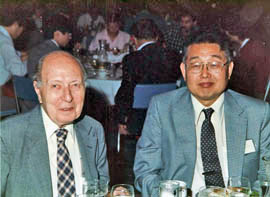
Wigner and Kim (1986). - Internal Space-time Symmetries. When Einstein formulated his special
theory of relativity in 1905, his particles did not have internal structures.
It was Eugene Wigner who first formulated a group theoretical approach to
internal space-time symmetries of those relativistic particles in his 1939 paper.
I did some work along this line, and constructed
this webpage as an extension of E = mc2.
Wigner was on my qualifying oral exam committee in 1959. He asked me whether I can produce the the low-energy neutron-proton scattering cross section from my memory. I said 20 barns. He said I was very close, and the accurate number is 18. He like me since then, and he published seven papers with me in his final years. I deserve this photo with him.

Wheeler and Kim in Maine (1991). - Warm Holes and Black Holes. Around 1952, John A. Wheeler became
interested in general relativity, and produced a student named Charles
Misner who received his PhD degree in 1957. Misner was admired by
younger graduate students at Princeton, and I was very happy to come
to the University of Maryland in 1962 because he was coming to the
same place.
While I was a student (1958-61), Wheeler was interested in worm holes and used his cartoonist talent to draw pictures of those worm holes. Wheeler attempted to trap me into one of his wormholes, but I carefully avoided. I do not know whether I was right or wrong.
Yet, Wheeler was interested in many things in physics and many things in the world. To him, I was crazy enough to be watched. I frequently visited him, and I maintain a photo album about him.
Through my association with Wheeler, I was able to develop a very important scientific tool: draw pictures and figures. R. P. Feynman used to communicate with Wheeler with diagrams, and he was able to develop Feynman diagrams.
- Click here for
the magic of cartoons.
The black hole these days is a very important Einstein issue. I would venture to say that its origin can be traced to Wheeler's instinct to draw cartoons to formulate his ideas.

Weber and Kim (1988). - Gravitational Waves. Joseph Weber became a controversial
figure when he announced he detected gravitational waves coming from
outer space, but we all agree that he was the pioneer in this important
field. The antennas he built for detecting gravitational waves are
known as the Weber bars. Here are some
photos of those Weber bars.
I met him when I came to the University of Maryland in 1962. We used to be the two hardest-working members in our department until he left us in 2000. When he was thinking of sending his son to Carnegie Mellon, he had an extensive talk with me. I deserve this photo with him.
For forty years, Joe Weber was able to pursue his research with determination under extremely hostile environment. Since 1965, after publishing my paper on the Dashen-Frautschi fiasco, I became very unpopular among American physicists, even though I was right and was able to keep my position in the United States. I also had to move against the wind. It was not unusual for me to receive three or four rejections before publishing one paper. For my paper on Feynman's rest of the universe, it took me eight years to publish in 1999. In order to understand this abnormal environment, I had to use my early Christian background to formulate the concept of Herod Complex.
I think Joe Weber was stronger than I was. Like Albert Abraham Michelson, he received his undergraduate education from the U.S. Naval Academy in Annapolis. Annapolis is a beautiful city about 60 kilometers east from Washington, and I go there occasionally for rest and relaxation. I think of these two graduates of the Naval Academy.
Einstein in Washington
- Washington is the capital city of the United States. When you come
to this city, you are interested in where the Whitehouse is. You
will then be surprised to see that the Einstein monument is within a
walking distance of the Whitehouse.
If you are not the president of your country, but are invited by the Whitehouse, you are likely to be asked to stay at Hay Adams Hotel about 200 meters north on the 16th Street. You will be happy to hear that you do not need an invitation from the Whitehouse to stay in this hotel. I once stayed, and the hotel was OK.
- Click here for a map leading you
from Hay Adams to the Einstein Monument.
- Metaphysics derivable from Washington.
Einstein was profoundly influenced by the culture of Koenigsberg in two
ways.
- Lorentz covariance of Maxwell's equations established by Hermann Minkowski
who studied at the University of Koenigsberg.
- The observer-dependent philosophy of Immanuel Kant who spent 80 years of his entire life in Koenigsberg. It is believed that Kant's philosophy was profoundly influenced by the geography and life style of his city.
I understand Maxwell's equations and their Lorentz covariance, but I am not able to understand what Kant says in his books. For me, the only way to see the content of Kantianism to go to his city, and study its geography. After 1945, Koenigsberg became a Soviet city called "Kaliningrad," which served as a secret submarine base for the Baltic fleet of the Soviet navy. When I went there in 2005, the city did not have a civilian jet airport, and I had to rely on a propeller-driven Polish airplane. Yet, I learned many things from my trip, and here is my Kaliningrad page.

This map is from Anne Applebaum's book on Kaliningrad. - Lorentz covariance of Maxwell's equations established by Hermann Minkowski
who studied at the University of Koenigsberg.
- I learned there that Koenigsberg was like Italy's Venice, a harbor city
with big lagoons. It served as the trade center for the Baltic Sea. People
with different ideas come to this place with different viewpoints. Kant was
interested in finding a common ground for those different people. This is
what Kantianism was all about.
- While I was in Kaliningrad for three days and two nights, I was able to
see that the philosophy of Taoism has the same origin as Kantianism. It is
said that China's history is 10,000 years old, but China is a relatively new
country. It was not until 5,000 years ago that different groups of people
came to the banks of China's two great rivers to construct civilization.
They found out not all the people have the same opinion, and that there is always an opposite view for a given point of view. They thus developed a philosophy of Taoism where the universe consists of Yang (plus) and Ying (minus), and then the harmony of the two. I have a webpage indicating that Einsteinism is closer to this Taoism than to the original form of Kantianism.
Click here for the webpage. - There is another important new country with the most stable political
system known to human history, namely the United States. We all know how
this country was formed, and how it is changing. The country has a
two-party system. People's opinions are different, but they can be
grouped into two. Then they find a harmony between the two.
It is not unlike the philosophy of Taoism or Einsteinism. Then did American politicians study Taoism or Einsteinism? Most likely, they never heard of these words. The question then is how they developed this bi-partisanship. I am not making a mistake in saying that this system was developed by bootstrap processes.
For a brief period (1962-67), many physicists believed that the ultimate physical theory can be developed by bootstrap processes. We do not take this idea seriously these days, but we should not rule out the possibility of a new philosophy or a new physical theory emerging from this American experience, namely bootstrapism.
I stayed in the Washington area for one half century since 1962. I am entitled to make some observations of Washington's culture with my physics background, as Kant did from his city of Koenigsberg.
Y. S. Kim (2010.3.12)
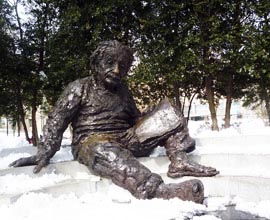
|
|
Einstein Monument in Washington, located within a walking distance
from the Whitehouse. Click here for the map. |

|
-
copyright@2010,2015 by Y. S. Kim, unless otherwise specified.
